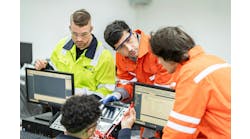Much has been written about what is a programmable logic controller (PLC), programmable automation controller (PAC) and industrial PC (IPC). If there is any real competition between a PLC and a PAC and an IPC, the game has already been played. The result was a draw, unless there are special circumstances, or you are just a big fan of a particular platform or programming method. The fact is the big automation users, such as the automotive industry, have already picked a winner, and it is likely a family of controllers from a single manufacturer that range from small to large system control capabilities.
Other industry segments, such as machine tools, metalworking machinery, machine builders and OEM equipment suppliers, have likely standardized on a controller or at least a controller brand. It certainly pays to minimize the number of controller suppliers. While a system integrator may sell services to support any controller manufacturer, it will have its favorite, and it's likely based on a manufacturer and not whether it is a PLC, PAC or IPC.
The PLC is the pioneer of the automation field and has been around since the late 1960s. It saw a massive growth in its use through the ’70s and ’80s. The PLC spread its wings in the 1980s when remote and distributed I/O became popular. The IPC was going to take over the world in the ’90s but didn't. And, in the early 21st century, the PAC was born.
Automation grew with the development of PLCs, PACs and IPCs. When the PLC was born, automation was using relays and sensors to control machines—millions of relays. The PLC wasn't just replacing relays; it helped automation and its complexity to grow.
Small, medium or large
All I need is a PLC, right? Isn't a PAC better? Can't the IPC can do more? Forget about the comparison; most can do much of what the others can and almost as well. Yes, each type of controller does something better than the others. Your automation vendor can give you a sales pitch on that. However, technology has merged or at least muddied the field when it comes to a modern automation controller's capabilities and functionality. It's likely that any of them would work in an automation application, as long as the right size of controller is selected.
There are some things to consider when selecting a modern automation controller. Cost, capabilities and support are three big hitters. A wide range of controllers are available, and their costs often follow capabilities.
Some critical capabilities when selecting a PLC, PAC or IPC are the amounts of I/O, communications and special requirements such as motion-control or safety-PLC functionality. These special-circumstance applications need to be carefully considered.
The size of the automation project is proportional to the size of the controller's capabilities. Although the trend is that a controller's physical size is shrinking, small-, medium- and large-controller capabilities are made for that simple reason. Count up the I/O needed and clearly define the devices controlled; then plan for future expansion. Many controllers may reach their limit of I/O in medium to large systems without proper selection.
It's a special case if a controller needs to provide two, three or more axes of coordinated motion, so choose carefully. Many controllers can talk to a servo drive using a variety of communication methods to command speed or position, but few can coordinate that motion as needed to draw a circle. Safety performed in a PLC is another special case. These motion or safety requirements narrow the choices for automation controllers.
Most controllers have Ethernet as a communication option and, in the age of the Industrial Internet of Things (IIoT), should be required. However, don't forget the communication protocol. Ethernet TCP and EtherNet/IP are two completely different protocols, and this can be a big differentiator in controllers. There are many industrial Ethernet protocols to choose from, and the speed of communication and the number of connections are important to quantify during selection. There is a big difference between an information message and real-time control when it comes to Ethernet. Also, some controllers, especially the PACs and IPCs, can often talk to many more devices at the same time.
When selecting a controller, a first step is to determine what the customer's or factory's standard controllers are. It may be necessary to open some control enclosures and check the brand and models used to ensure proper support.
Support is a big driver in selecting an automation controller. There should never be competition between controller manufacturers on the factory floor. Pick one. The controller manufacturer chosen has a large effect on the support available in a factory. The control-system personnel in a plant are typically trained to use a family of controllers from a single manufacturer. They also likely only have that manufacturer's software loaded on their work computer. A factory floor with controllers from multiple manufacturers is poorly planned and often slows down the troubleshooting of poorly operating machines and equipment failures.
In the past, the amount of controller memory was a problem and controllers did run out of memory, so always plan for expansion and maybe select a larger controller. For the most part, technology has fixed that problem. Now one of the differentiators may be onboard data logging availability.
When choosing a controller, quantify your requirements as small, medium or large; plan for a little expansion; and pick the factory favorite. It will work great in most applications for decades.






